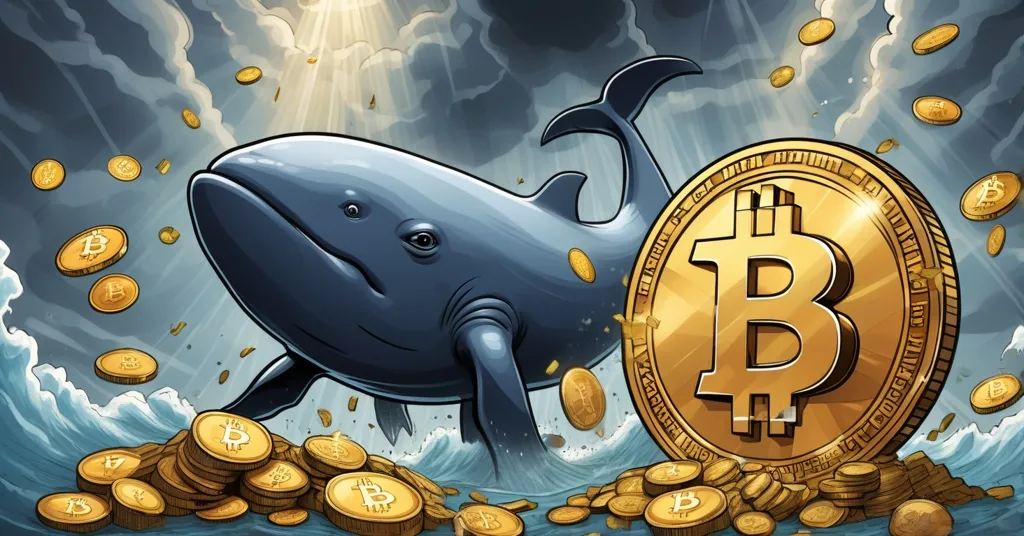Bitcoin Stalls Below $111,900 Despite BlackRock and Metaplanet’s Massive Buying Spree

Why Is Bitcoin Stuck Below $111,900 Despite Record Institutional Buying?
Bitcoin is in the midst of a historic wave of institutional adoption, with financial titans like BlackRock and Japanese firm Metaplanet amassing massive stacks of BTC at breakneck speed. Yet, even with this unprecedented demand, the price lingers below its all-time high of $111,900, currently hovering around $108,700. What’s holding it back?
- Institutional Power Play: BlackRock holds over 700,000 BTC, while Metaplanet boasts 15,555 BTC with staggering returns.
- Price Resistance: Bitcoin struggles to break its peak, trading near $108,700 after a recent dip.
- Opposing Forces: Trump’s tariffs and whale sell-offs clash with institutional momentum.
The Institutional Boom: Numbers That Stagger
Let’s start with the big players rewriting Bitcoin’s ownership map. BlackRock, the heavyweight of asset management, has accumulated over 700,000 BTC through its spot Bitcoin ETF (IBIT), launched less than two years ago. That’s roughly 3.5% of Bitcoin’s total 21 million supply, with a jaw-dropping $76.35 billion in assets under management. Their pace is ruthless—averaging 40,000 BTC per month, or about 1,300 BTC daily. If this continues, projections suggest they’ll hold 1.2 million BTC by May 2026, closing in on the rumored stash of Bitcoin’s creator, Satoshi Nakamoto. Bloomberg analyst Eric Balchunas summed up the scale of this shift:
“BlackRock now holds 700,000 BTC and is 62% of the way toward surpassing Satoshi.”
For those new to the game, a spot Bitcoin ETF allows investors to gain exposure to BTC’s price without directly owning it, acting as a bridge between traditional finance and crypto. BlackRock’s aggressive accumulation signals a growing belief in Bitcoin as a store of value—a digital gold of sorts—to hedge against inflation and fiat currency erosion. This isn’t a fringe experiment anymore; it’s a calculated move by Wall Street’s biggest names, spurred by the U.S. approval of spot Bitcoin ETFs in early 2024, which opened the floodgates for mainstream capital. To understand more about this trend, check out the broader context of Bitcoin institutional adoption.
Halfway across the world, Metaplanet, a Japanese company, is making its own mark with 15,555 BTC on its balance sheet, acquired at an average price of $99,307 per coin for a total of $1.54 billion. Their latest purchase of 2,205 BTC at $108,237 each, costing $238.7 million, has delivered a year-to-date BTC yield of 416.6%—a metric reflecting the growth in Bitcoin’s value per share for investors. CEO Simon Gerovich didn’t shy away from highlighting this success:
“We acquired 2,205 BTC for ~$238.7 million at ~$108,237 per bitcoin, achieving a BTC yield of 416.6% YTD.”
Metaplanet now ranks as the fifth-largest corporate Bitcoin treasury holder, behind Strategy, MARA, Twenty One Capital, and Riot Platforms. For the uninitiated, a Bitcoin treasury is when a company holds BTC as a reserve asset on its balance sheet, much like stashing gold or cash to protect against economic uncertainty. Dive deeper into their approach with this detailed look at Metaplanet’s Bitcoin treasury strategy. Other firms like MARA Holdings and Semler Scientific are following suit, reflecting a broader trend of corporations betting on Bitcoin as a strategic play. But if the big money is pouring in, why isn’t the price soaring past its previous peak?
Bearish Headwinds: Tariffs and Whales Bite Back
The answer lies in a brutal clash of forces dragging Bitcoin down even as institutions push it up. First up, macroeconomic turbulence. Recently announced tariffs by Donald Trump, targeting 14 countries including Japan and South Korea with rates up to 40% starting August 1, 2025, have rattled global markets. Bitcoin wasn’t spared, dropping 1.56% to below $108,000 from a weekly high above $109,000. These tariffs, aimed at addressing trade imbalances, inject uncertainty into financial systems, proving that even a decentralized asset like Bitcoin can’t fully dodge the fallout from traditional economics. For a closer look at this development, see the impact of Trump’s tariffs on cryptocurrency markets. While BTC showed relative resilience—Ethereum slid 1.89% to $2,535 and Dogecoin tanked 4.78%—the dip underscores a harsh reality: global trade wars still mess with crypto’s vibe.
But tariffs are just one piece of the puzzle. Enter the Bitcoin whales—early adopters or miners with massive holdings who can swing markets with a single transaction. Reports suggest these heavyweights have offloaded over 500,000 BTC in the past year, roughly matching the inflows from ETFs. One whale recently moved 80,000 BTC, potentially signaling a sell-off. Think of it like a major shareholder dumping millions of shares of a stock at once; the sudden flood of supply can tank the price, directly countering institutional demand. While exact figures need deeper on-chain analysis from tools like Glassnode or Chainalysis, the pattern of long-term holders cashing out near all-time highs is a well-known dynamic. For some community insights on this, explore this discussion on why Bitcoin’s price remains stuck despite institutional buying. These early Bitcoin millionaires are pocketing profits faster than a kid flipping candy before Halloween, leaving the rest of us to deal with the price hangover.
Let’s not ignore the broader context of why Bitcoin might be vulnerable to such shocks. Despite its decentralized nature, BTC remains a risk asset in the eyes of many investors, often correlating with market sentiment in equities or other speculative plays. When geopolitical fears—like tariffs sparking recession worries—hit, risk-off behavior can outweigh Bitcoin’s safe-haven narrative. Add to that a reported $350 billion single-day spike in U.S. debt, and you’ve got a recipe for fiat instability that should, in theory, boost Bitcoin. Yet, short-term panic often trumps long-term logic in these markets. For further reading on this dynamic, consider this analysis of the impact of tariffs on Bitcoin’s price.
The Centralization Conundrum: A Bitter Pill for Purists
Zooming out, there’s a deeper tension brewing beneath the surface of this institutional gold rush. Bitcoin was forged as a rebellion against centralized financial systems—a peer-to-peer middle finger to banks and governments. Now, with BlackRock potentially outpacing even Satoshi’s holdings, are we trading that vision for Wall Street’s seal of approval? It’s a tough question for Bitcoin maximalists like myself who champion decentralization and personal freedom. Sure, institutional capital pumps the price and cements Bitcoin’s legitimacy, but at what cost? If a handful of financial giants own a disproportionate slice of the pie, doesn’t that undermine the very ethos of a system meant for the people? Community perspectives on this can be found in this Reddit thread about BlackRock’s Bitcoin holdings.
On the flip side, this influx of heavy hitters could be the rocket fuel Bitcoin needs to become the future of money. BlackRock’s involvement brings infrastructure, regulatory clarity, and mainstream trust—elements that small-scale, community-driven mining pools or node operators can’t match alone. Compare this to past centralization scares, like the Mt. Gox collapse in 2014 when a single exchange held too much power; today’s risks are different but no less real. It’s a trade-off: disruption of the status quo via adoption, versus the slow creep of control by the very systems Bitcoin sought to upend. As advocates of effective accelerationism, we cheer the pace of change, but we’re not blind to the irony.
Let’s also consider the risks tied to corporate treasuries. While Metaplanet’s 416.6% yield is eye-popping, not everyone is sold on this strategy. Matthew Sigel, Head of Digital Asset Research at VanEck, offers a dose of skepticism:
“Easy gains might already be gone for new entrants.”
Sigel points to potential dilution from at-the-market (ATM) share issuance programs—where companies sell shares at current prices to raise capital—which could hurt investors if stock prices hover near the net asset value of their Bitcoin holdings. Legal headaches loom too; Strategy, a top Bitcoin treasury holder, faces a class action for allegedly misleading investors. These are stark reminders that corporate adoption isn’t a guaranteed moonshot. Regulatory scrutiny, from SEC oversight of ETFs to potential crackdowns on corporate treasuries, adds another layer of uncertainty. Bitcoin’s freedom comes with strings when suits get involved. For specifics on BlackRock’s impact, take a look at their ETF holdings surpassing 700,000 BTC.
Bitcoin vs. the Broader Crypto Market: A Safe Haven?
Amidst these headwinds, it’s worth noting Bitcoin’s relative strength compared to other cryptocurrencies. While BTC dipped 1.56% post-tariff news, altcoins took a harder hit—Ethereum’s drop shows riskier assets bleed faster in a crisis. This reinforces a Bitcoin-maximalist view that BTC is the closest thing to a safe harbor in the crypto space, even if it’s not immune to global chaos. That said, other blockchains like Ethereum serve niches Bitcoin doesn’t aim to fill—think smart contracts and decentralized apps. Diversification isn’t a bad play for some, even if my heart stays with BTC as the ultimate disruptor of fiat tyranny.
Could altcoins or other hedges steal Bitcoin’s thunder if price stagnation persists? Possibly, but Bitcoin’s narrative as digital gold holds stronger during uncertainty, especially with institutional backing. Historical patterns, like BTC price spikes during past U.S.-China trade tensions, suggest tariffs could eventually drive more into Bitcoin if fiat systems keep buckling under debt. It’s just a damn shame we’ve got to slog through whale dumps and geopolitical mess to get there. For more on why the price isn’t reflecting this buying spree, read about institutions buying Bitcoin in record numbers.
Looking Ahead: Growing Pains or a Setback?
Bitcoin’s current state feels like a battlefield—optimism fueled by institutional muscle, clashing with real-world obstacles like tariffs and profit-taking whales. For every BlackRock milestone or Metaplanet yield report, there’s a trade war scare or massive sell-off waiting to crash the party. Yet, this friction signals Bitcoin’s coming of age. It’s no longer just a rebel’s toy; it’s navigating the gritty reality of global finance while still holding the banner of freedom and privacy. Some analysts throw out wild targets like $120,000 or $130,000, but let’s cut the nonsense—those are just guesses, often shilled for clicks. Real adoption, not hype, drives this revolution.
As champions of decentralization, we see this tug-of-war as proof of Bitcoin’s disruptive power, even if the road is bumpy. Institutional buying post-2024 ETF approvals, paired with maturing infrastructure like the Lightning Network for scalability, shows Bitcoin isn’t just surviving—it’s positioning to redefine money itself. But we can’t ignore the risks of centralization, regulatory traps, or external shocks. This isn’t a straight shot to utopia; it’s a wild, messy ride, and we’re strapped in for every twist.
Key Questions and Takeaways
- Why are institutions like BlackRock and Metaplanet piling into Bitcoin?
They view Bitcoin as a store of value and hedge against inflation, with BlackRock holding 700,000 BTC and Metaplanet achieving a 416.6% year-to-date yield on their 15,555 BTC stash. - What’s stopping Bitcoin from breaking its $111,900 all-time high?
Macroeconomic shocks like Trump’s tariffs on 14 countries and whale sell-offs of over 500,000 BTC in the past year are countering institutional demand, keeping the price near $108,700. - Does institutional adoption threaten Bitcoin’s decentralization?
Yes, giants like BlackRock potentially owning more than Satoshi clash with Bitcoin’s peer-to-peer roots, though their capital also boosts legitimacy and infrastructure for broader adoption. - How do geopolitical events affect a decentralized asset like Bitcoin?
Even Bitcoin feels the sting of global uncertainty—tariffs triggered a 1.56% price drop, showing traditional economic forces still sway crypto markets in the short term. - Are whale sell-offs a serious risk to Bitcoin’s price momentum?
Damn right, large transactions like a recent 80,000 BTC movement can flood supply, offsetting institutional buying and stalling upward movement until demand catches up.



